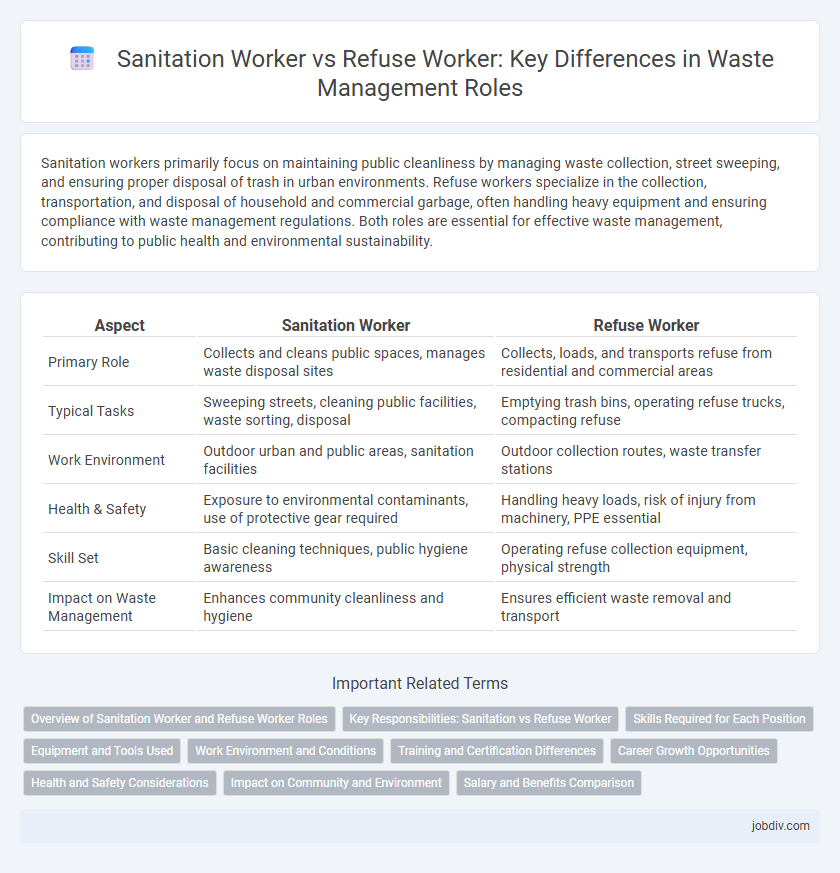Sanitation workers primarily focus on maintaining public cleanliness by managing waste collection, street sweeping, and ensuring proper disposal of trash in urban environments. Refuse workers specialize in the collection, transportation, and disposal of household and commercial garbage, often handling heavy equipment and ensuring compliance with waste management regulations. Both roles are essential for effective waste management, contributing to public health and environmental sustainability.
Table of Comparison
| Aspect | Sanitation Worker | Refuse Worker |
|---|---|---|
| Primary Role | Collects and cleans public spaces, manages waste disposal sites | Collects, loads, and transports refuse from residential and commercial areas |
| Typical Tasks | Sweeping streets, cleaning public facilities, waste sorting, disposal | Emptying trash bins, operating refuse trucks, compacting refuse |
| Work Environment | Outdoor urban and public areas, sanitation facilities | Outdoor collection routes, waste transfer stations |
| Health & Safety | Exposure to environmental contaminants, use of protective gear required | Handling heavy loads, risk of injury from machinery, PPE essential |
| Skill Set | Basic cleaning techniques, public hygiene awareness | Operating refuse collection equipment, physical strength |
| Impact on Waste Management | Enhances community cleanliness and hygiene | Ensures efficient waste removal and transport |
Overview of Sanitation Worker and Refuse Worker Roles
Sanitation workers specialize in maintaining public health by collecting, cleaning, and disposing of waste materials to ensure hygienic environments. Refuse workers primarily focus on the collection and transportation of garbage from residential and commercial areas to disposal sites. Both roles are essential in waste management but differ in their operational focus and specific job responsibilities.
Key Responsibilities: Sanitation vs Refuse Worker
Sanitation workers primarily handle the cleaning and maintenance of public spaces, ensuring streets, parks, and sidewalks remain free of litter and debris to promote public health. Refuse workers focus on the collection, transportation, and disposal of solid waste, managing residential, commercial, and industrial garbage to prevent environmental contamination. Both roles contribute to effective waste management but differ in their operational scope and tasks within the sanitation ecosystem.
Skills Required for Each Position
Sanitation workers require skills in handling hazardous materials, operating cleaning machinery, and ensuring public hygiene through waste collection and street cleaning. Refuse workers need proficiency in sorting recyclable materials, operating compactors or refuse trucks, and knowledge of waste segregation regulations. Both roles demand physical stamina, adherence to safety protocols, and the ability to work in varying environmental conditions.
Equipment and Tools Used
Sanitation workers primarily use high-pressure water jets, cleaning brushes, and protective gear such as gloves and boots to maintain hygiene in public spaces. Refuse workers rely on compactors, garbage trucks with hydraulic lifts, and hand tools like rakes and shovels for waste collection and disposal. Both roles require specialized equipment designed to improve efficiency and ensure worker safety in waste management operations.
Work Environment and Conditions
Sanitation workers typically operate in residential and urban areas, managing waste collection with exposure to varying weather conditions and physical hazards such as heavy lifting and traffic risks. Refuse workers often handle industrial or commercial waste, facing more concentrated exposure to hazardous materials and requiring specialized protective gear to manage chemical, biohazard, or sharp waste safely. Both roles demand rigorous adherence to safety protocols, but refuse workers generally encounter more variable and potentially dangerous work environments due to the nature of materials processed.
Training and Certification Differences
Sanitation workers receive specialized training in hygiene management, disease prevention, and safe waste disposal techniques, often requiring certifications such as OSHA Hazardous Waste Operations. Refuse workers focus on the operation of waste collection vehicles and the mechanical handling of solid waste, with training emphasizing equipment safety and driver's licensing requirements. Certification for refuse workers typically includes commercial driver's licenses (CDL) and safety compliance courses specific to waste transportation.
Career Growth Opportunities
Sanitation workers often have broader career growth opportunities through specialized training in hazardous waste management and public health, enabling advancement into supervisory or environmental compliance roles. Refuse workers can progress by gaining skills in equipment operation or recycling technology, leading to positions such as crew leader or waste management coordinator. Both career paths benefit from certifications related to environmental safety and municipal waste regulations, enhancing promotion prospects.
Health and Safety Considerations
Sanitation workers primarily handle the collection and disposal of human waste, requiring strict adherence to infection control protocols to prevent exposure to pathogens like hepatitis and gastrointestinal bacteria. Refuse workers manage general solid waste, facing risks from hazardous materials such as sharps, chemicals, and heavy lifting injuries, necessitating the use of personal protective equipment (PPE) like gloves, masks, and steel-toed boots. Both roles demand comprehensive health monitoring and safety training to mitigate occupational hazards and ensure compliance with OSHA regulations.
Impact on Community and Environment
Sanitation workers play a critical role in maintaining public health by managing sewage and preventing the spread of diseases, directly impacting community well-being and environmental quality. Refuse workers focus on the collection and disposal of solid waste, reducing pollution, mitigating landfill overflow, and promoting recycling efforts that benefit ecosystems and urban areas. Both professions are essential for sustainable waste management, collectively enhancing environmental hygiene and community safety.
Salary and Benefits Comparison
Sanitation workers typically earn an average annual salary between $ thirty thousand and $ forty thousand, while refuse workers often receive slightly higher pay, ranging from $ thirty-five thousand to $ forty-five thousand. Benefits for sanitation workers commonly include health insurance, retirement plans, and paid leave, whereas refuse workers may have additional hazard pay and overtime opportunities reflecting the physically demanding and hazardous nature of refuse collection. Both roles receive union representation in many regions, contributing to negotiated wage increases and comprehensive benefits packages.
Sanitation Worker vs Refuse Worker Infographic

 jobdiv.com
jobdiv.com